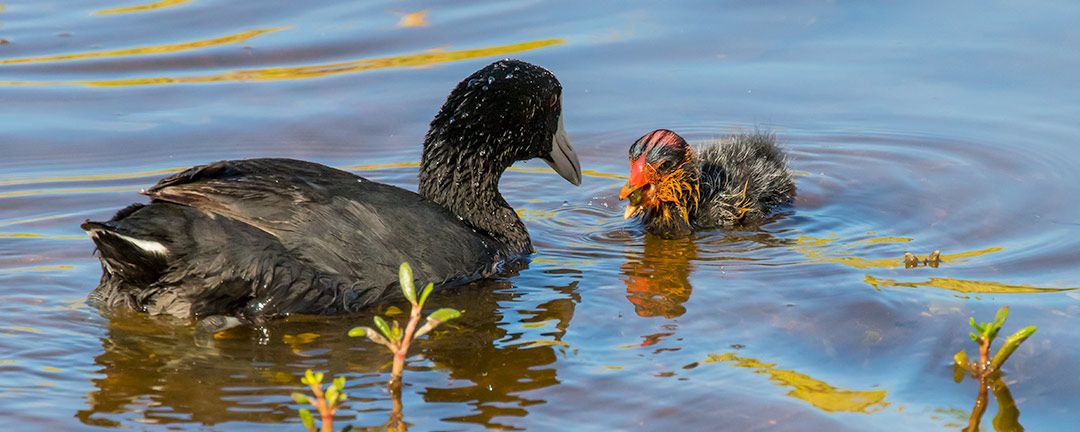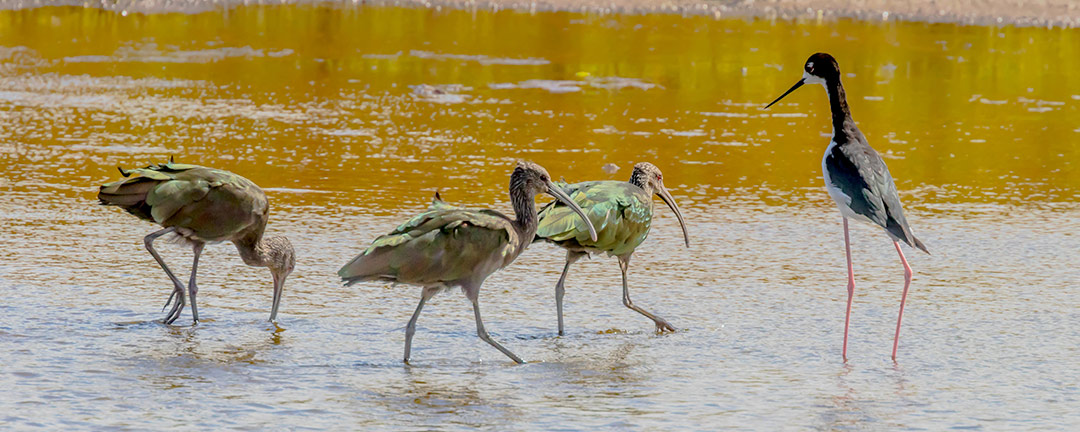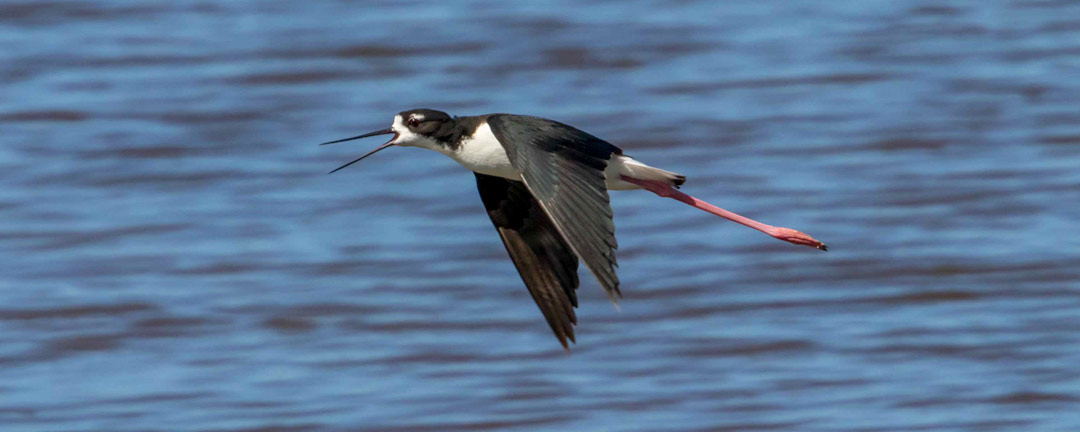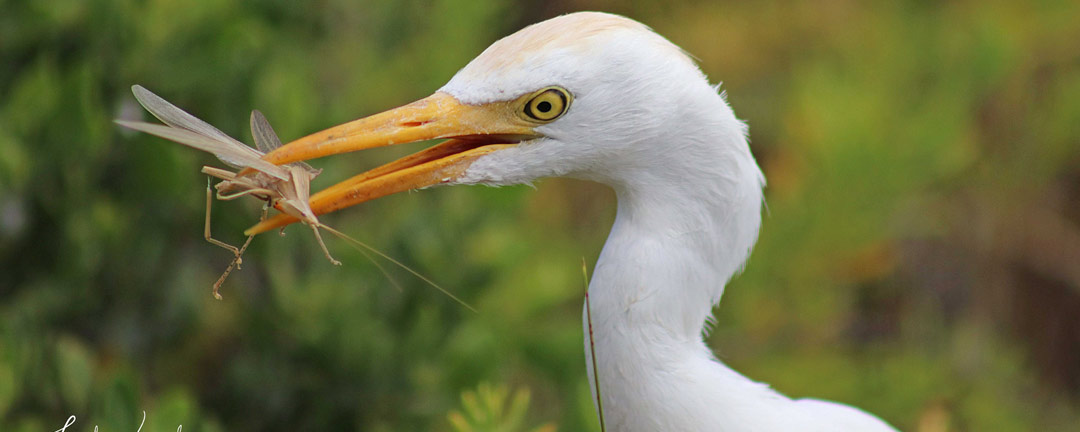Welcome to Friends of Keālia Pond National Wildlife Refuge,
a nonprofit formed in 2014 to advocate for the Keālia Pond National Wildlife Refuge.
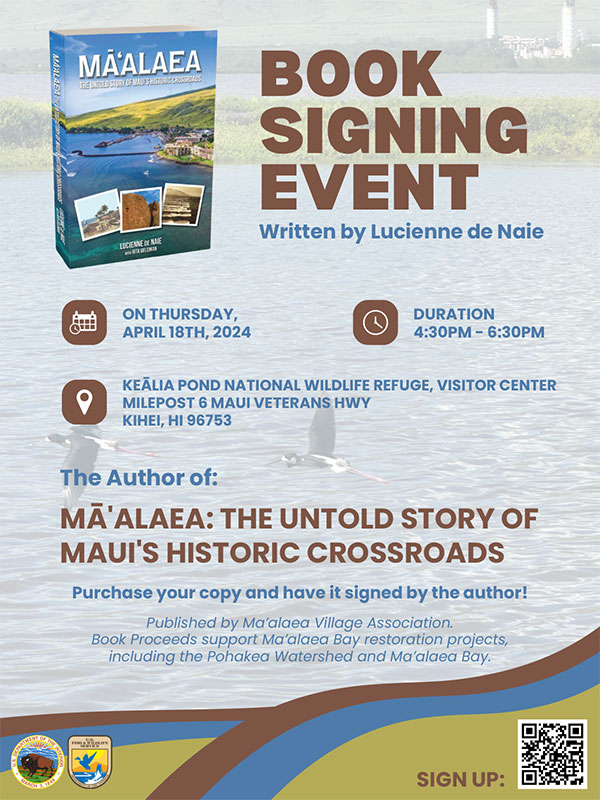
BOOK SIGNING EVENT
with Lucienne de Naie
The Author Of:
Mā‘alaea: The Untold Story Of Maui’s Historic Crossroads
Thursday, April 18th, 2024
4:30Pm – 6:30Pm
Keālia Pond National Wildlife Refuge, Visitor Center
Milepost 6 Maui Veterans Hwy
Kihei, HI 96753
Attendees must register to attend the presentation portion starting at 5:00 pm. The schedule is as follows:
4:30 pm Welcome reception
5:00 pm Presentation by Lucienne de Naie
5:30 – 6:30 pm book signing
Purchase your copy and have it signed by the author!
Published by Ma’alaea Village Association.
Book Proceeds support Ma’alaea Bay restoration projects, including the Pohakea Watershed and Ma’alaea Bay.
Keālia Pond National Wildlife Refuge, established in 1992 by the U.S. Fish and Wildlife Service, is a 704-acre natural wetland in Kihei, Maui.
It is home to the endangered Hawaiian stilt (ae‘o) and Hawaiian coot (‘alae ke‘oke‘o) as well as to indigenous black-crowned night herons (‘auku‘u) and one of the largest populations of migratory shorebirds in Hawaii. In addition, the Refuge manages coastal beach strand habitat for native plant species, endangered hawksbill turtles (honu‘ea), threatened Hawaiian green turtles (honu), and nesting wedge-tailed shearwaters (‘ua‘u kani).
For more information about Keālia Pond NWR, visit https://www.fws.gov/refuge/kealia_pond/

Friends of Keālia Pond National Wildlife Refuge 2024 Photography Contest
Friends of Keālia Pond National Wildlife Refuge in conjunction with Keālia Pond NWR are happy to announce a wildlife photography contest. Every photographer who enters will honor their own work and help to support the conservation mission of Friends of Keālia Pond National Wildlife Refuge, which includes improving visitors’ experience, developing environmental and educational activities, offering volunteer assistance with refuge projects, and establishing fundraising sources.
The refuge at the fish ponds, just past the visitor center, will be open to the public on the first Saturday of each month, from 9 am to 5 pm until June of this year.
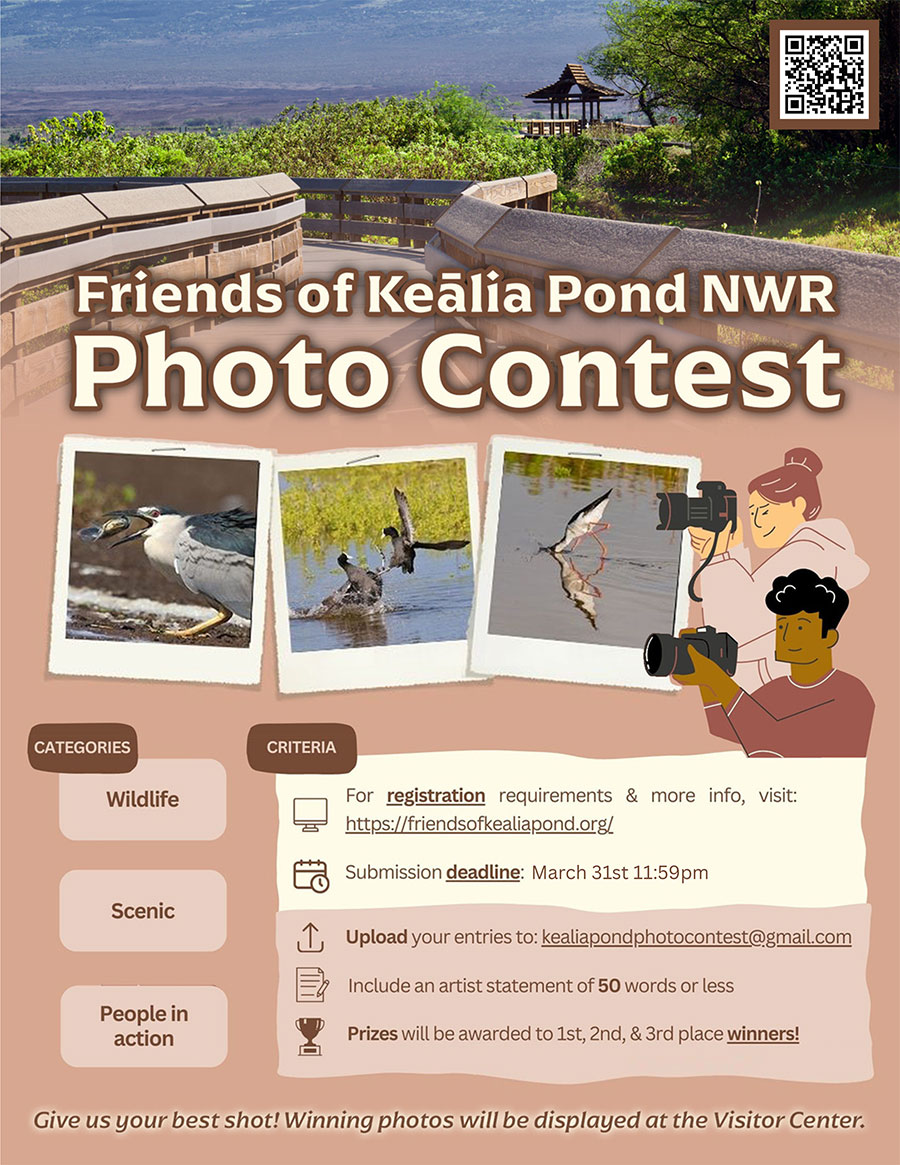
Entry Deadline
The contest begins Feb. 1, 2024 and ends March 31, 2024, at midnight Hawaii time.
What to Enter
The following three contest categories are open in three age divisions:
Age Divisions:
- Adult, 18yrs. of age or more.
- Teen, 13 to 17 yrs. of age
- Youth, 12 yrs. of age and under
Contest categories:
- Wildlife: Birds, plants, as well as other animals and insects found in the refuge.
- Scenic: Plants and landscapes, as well as geological features. You can feature wildlife in this category, but it should not be the main feature.
- People in action: Photos of events, objects, or activities connecting people to the conservation, habitat restoration, and educational missions at Keālia Pond NWR. Photos may not include wedding parties, birthday parties or private outings. If a person is recognizable in the photo, you must have their permission to share the photo.
All photos must be taken on refuge sites that are open to the public:
- Keālia Coastal Boardwalk, North Kihei Road
- Keālia Pond NWR Visitor Center, at Milepost 6 on Mokulele Highway (Maui Veterans Highway), Kihei
- Keālia NWR wildlife viewing ponds (Kanuimanu Ponds, near the Visitor Center)
Entry Information
- Please submit digital photographs and requested information online through the following email address: kealiapondphotocontest@gmail.com We do NOT accept photographs submitted through the mail or at the Visitor Center.
- Each contestant may submit up to 3 photos total.
- Each photograph must be submitted in .JPG format and cannot exceed 4 MB in size. Photos must be in an 8×10 aspect ratio (either landscape or portrait). Please do NOT submit images with watermarks or logos, as this can muddle the judging process.
- When submitting, include the following information:
a. Name
b. Division (Adult, Teen, or Youth) and Category (Wildlife, Scenic, People in action). Please send one email per photograph and indicate in the subject line the Division and Category.
c. If under 18, indicate the age of the entrant.
d. Include a typed artist statement of 50 words or less in the body of the email. The statement should be a brief description of where the photo was taken (boardwalk, ponds, Visitor Center) and the story, if any, behind the photograph. Please name any birds, animals, or plants featured in the photograph if possible. You can also share a little bit about yourself, if you want!
The artist statement will be displayed with winning artwork.
Judging Criteria and Rules
- Photos must be taken at Keālia Pond National Wildlife Refuge at areas open to the public, as described above.
- Photos will be judged on originality, technical quality, composition, and artistic merit.
- All photos must accurately reflect the subject matter as it appeared in the viewfinder. Normal processing of RAW images files and minor adjustments to color and contrast are acceptable, but nothing should be added to an image.
- Entrants must not infringe on the rights of any other photographer or person, or submit images that involve the willful harassment of wildlife or damage to the environment by the photographer. Drone photography is not permitted on the refuge. Drone photos will be disqualified.
- Any contestant may win only one award in total.
- Judges have the right to disqualify incomplete entries.
Please do not contact us about the status of entries or judging. Winners will be announced on our website (https://friendsofkealiapond.org).
First, second, and third place winners, as well as honorable mentions, will be displayed at the Visitor Center, at Milepost 6 on Mokulele Highway (Maui Veterans Highway), Kihei. In addition, photos will be shared on social media. Prizes will be awarded to first, second, and third place winners. Time and location to be announced at the end of the judging period.
Friends of Keālia Pond will retain all photographs it prints and displays at the Visitor Center, but will not use them in any other manner without permission from the photographer. Entrants retain the rights to their work.
Friends of Keālia Pond National Wildlife Refuge is a volunteer-based non-profit that serves to support the refuge with funding, grant applications, and volunteer support for the mission of the refuge. To that end we seek donations from the public and offer membership as a “Friend of Keālia Pond.” Please consider joining us to further conservation awareness in our community. Become a member for $20 a year (January-December for the calendar year that you join in), or $10 if you are joining for the first time in any month other than January. Member benefits include up to 20 percent off selected store merchandise and free attendance at lectures and presentations offered by Friends of Keālia Pond NWR.
This photo contest is an example of our efforts to engage the public in activities supporting the refuge. We ask that you consider becoming a Friend of Keālia by clicking HERE. Clicking will link you to our membership page which will allow you to make a first-year donation of $10 to be included as a Friend of Keālia. Payment may be made using PayPal, a credit card, or mailing a check, payable to Friends of Keālia Pond NWR, to:
Friends
Maui National Wildlife Refuge Complex
P.O. Box 1042
Kihei, HI 96753
Include your full name, address and email with your check payable to “Friends of Kealia Pond”
Our thanks in advance.
Taking a walk on the wild side at Kealia Pond
By Mia Charleston
Nicknamed the “patron saint of swamps”, author Henry David Thoreau once wrote “I enter a swamp as a sacred place, a sanctum sanctorum . . . I seemed to have reached a new world, so wild a place . . . ”. Fortunately here on Maui, there is a team of volunteers and the Friends of Kealia Pond (National Wildlife Refuge FKP) who share Thoreau’s view of wetlands. They are focusing their efforts on restoring the native plant communities in the Kealia Pond National Wildlife Refuge, that reflect the ecology of what might have existed before human settlement of the Hawaiian islands.
In 1992, the Kealia Pond National Wildlife Refuge (NWR) was established to preserve, restore and protect wetland habitat crucial for endangered waterfowl such as the Hawaiian coot (‘alae keʻokeʻo) and the Hawaiian stilt (aeʻo) which utilize the area for foraging and nesting. The U.S Fish and Wildlife Service manages the refuge, encompassing over 700 acres. Not only does the refuge have a large wetland ecosystem, but it also contains tropical shrublands and a coastal dune.
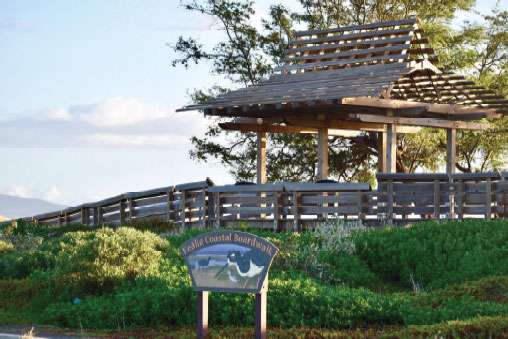
I had the pleasure of touring all three habitats with long-time volunteer and land steward, Sonny Gamponia, who is also a member of FKP. According to Sonny, in the 1980’s Rene Sylva began planting sandalwood, wiliwili and Pritchardia beccariana, a native loulu plam. Forest and Kim Starr extended the native plant community by restoring a section of the dunes with ʻakiʻaki, aweoweo and kou. Jack Hazen planted more trees in the mid-1990’s, volunteering at Kealia Pond until he was 91 years old! His work can be appreciated to this day as you drive through the visitor center entrance where hala and wiliwili trees welcome guests as they enter the refuge.
The Coastal Dune
In an effort to reestablish the ecological integrity of the ecosystem, volunteers have been conducting small experimental plantings. Their goal is to increase native plant growth and decrease invasive plant species (marsh fleabane, kiawe, buffel grass and pickleweed).
To track changes over time, two variables are measured: 1) proportion of native plant species among the grasses, ground cover, low shrubs, tall shrubs and trees in a given area; and 2) proportion of native root coverage of 10 x 10 meter sections of the same area. Both variables increased comparing from 2014 to 2017. Documentation of these changes can be seen at the following link: https://kealianwr.smugmug.com/Ecology
Increasing the root density with diverse native plant communities (ʻākulikuli, paʻu o hiʻiʻaka, pōhuehue, ʻilima, maʻo, naio, naio papa) has transformed small degraded sections of the dunes and coastal strand into functional habitat for pollinators and potential nesting sites for hawksbill sea turtles and wedge-tailed shearwaters.
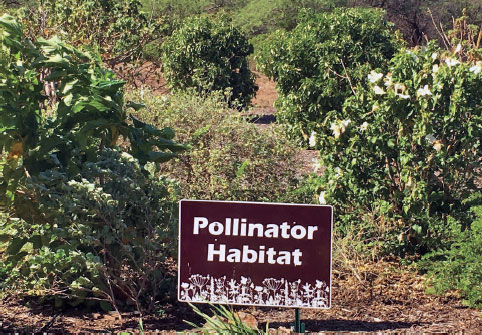
The Tropical Shrubland
One of the main objectives in the Kealia Pond NWR Comprehensive Conservation Plan for the tropical shrublands is to enhance habitat in order to attract the endangered ‘ōka‘i ‘aiea (Blackburn’s sphinx moth). A pollinator garden has been planted behind the visitor center primarily to attract the moth. Sonny is hopeful that the small native shrubland projects surrounding the pollinator garden will connect to provide habitat
of scale for endemic insects like the Kamehameha butterfly, koa butterfly, the Hawaiian yellow-faced bees, as well as the Hawaiian hoary bat.
In 2007, Stephanie Pau and a group of researchers studied soil samples from the middle of Kealia Pond. Pollen from 28 plant families were identified as having existed between 2500 BC to the 900 AD. At present, 14 of the 28 prehuman settlement species are growing on the refuge. There now nearly 50 species of native plants growing in small patches on refuge property including ʻaʻaliʻi, wiliwili, maʻo, kou, ʻākia, naupaka, hala, naio and ʻakiʻaki grass.
The Wetlands
The wetlands of Kealia are inundated with invasive Indian marsh fleabane, pickleweed and kiawe. Small patches of ʻakiʻaki grass and makaloa and kaluhā sedge remain. Once the invasive plants have been removed, wetland grasses spread on their own. Rhizomes from these essential wetland species can be used to expand critical wetland habitat for the Hawaiian stilt, Hawaiian coot, nēnē and migratory shorebirds.
Along with these projects done by community groups and individual volunteers, Sonny has his own pilot project to utilize small aeroponic systems to propagate native plant species. The aeroponic units would decentralize plant propagation from a single small greenhouse and expand native plant propagation to the general community.
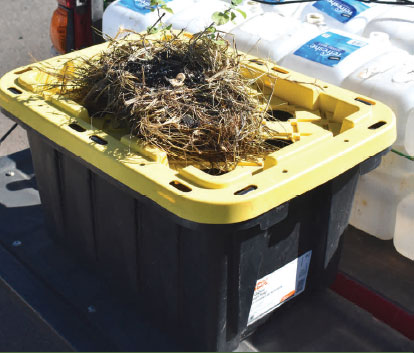
An example of the aeroponic kit being used in a pilot propagation project at Kealia Pond. This picture shows a small bale with a rooting plant on top.
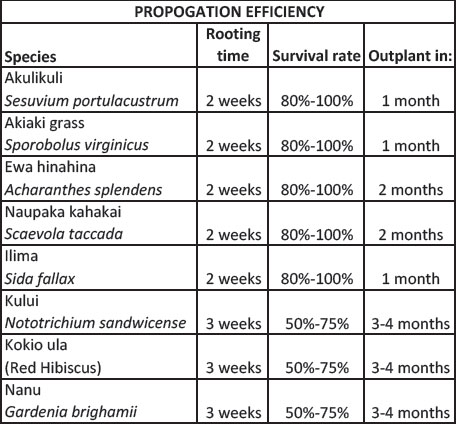
After purchasing a couple of aeroponic kits, Sonny built his own using materials from local hardware and gardening stores. He monitored propagation times and survival rates of native species used at the refuge.
The basic principal behind aeroponics is to suspend plant cuttings where root structures can be exposed to a mist of water and nutrients at regular intervals, basically replacing soil. Why replace the soil? According to studies performed by NASA aboard the Mir space station using adzuki beans, “Aeroponics systems can reduce water usage by 98 percent, fertilizer usage by 60 percent, and pesticide usage by 100 percent, all while maximizing crop yields. Plants grown in the aeroponic systems have been shown to
uptake more minerals and vitamins, making the plants healthier”. From the https://www.nasa.gov/vision/earth/technologies/aeroponic_plants.html.
The Friends of Kealia Pond is working on a project to loan aeroponic units to volunteers who wish to propagate cuttings for the native plant restoration projects at the refuge. Participants in this program will transplant the rooted cuttings into small bales of native grasses and native seeds. These bales, about the size of a loaf of bread, are “cured” and planted in shrublands wetlands and dunes at the refuge.
Based on the continued accumulative efforts of FKP, it seems hopeful they will obtain their goal of restoring the native flora to Kealia National Wildlife Refuge.
Sonny wanted to acknowledge that the restoration projects would not be possible without the pioneering work by Rene Sylva, Anna Palamino, Forest and Kim Starr and the Native Hawaiian Plant Society. The whole ecology of the Hawaiian tropical shrubland and coastal strand is near extinction. The trend is slowly being reversed with projects at Haleakalā National Park, Mākena, Kanahā Pond and Waiheʻe Wetlands and Coastal Dunes. Restoring native plant communities is the best gift we can give to the ‘aina.
If you would like to learn more about the refuge, the Visitor Center is open M-F from 8:00 a.m. to 3:30 p.m. and the coastal boardwalk is open seven days a week from 6:30 a.m. to 7:00 p.m. You can find Sonny and the FKP volunteers on Tuesday and Thursday mornings from 9:00 to 11:00.
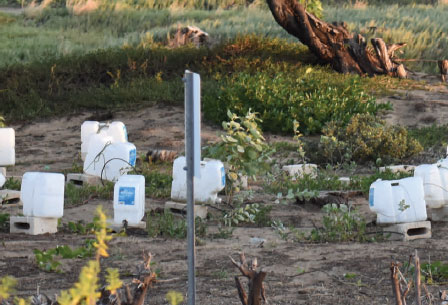
Thank you so much to Sonny Gamponia, his wife Diana Lyons, and all of the wonderful volunteers like Frank Krau and Carl Griffith, as well as the staff at the refuge who I met during my tour. Your work is truly motivating. Mahalo.
First published in the NHPS Newsletter, February 2019, pages 1-3, reprinted with the permission of the Native Hawaiian Plant Society.
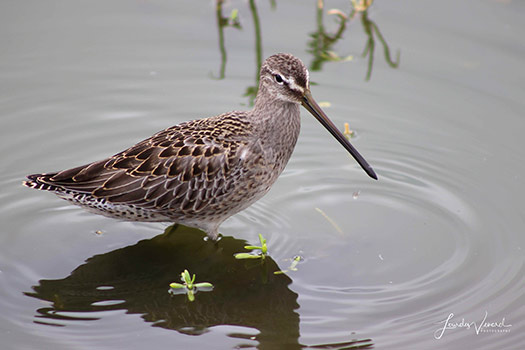
Mission Statement and Goals
Friends of Keālia Pond National Wildlife Refuge is dedicated to helping the Refuge achieve its mission of conserving and protecting essential wetland habitat by promoting a better understanding and appreciation of the natural environmental and native species of Maui County and, in particular, Keālia Pond NWR.
Our goals are to:
• Support the mission of Keālia Pond National Wildlife Refuge.
• Improve visitors’ experience by building trails, installing benches, and providing shady spots and viewing blinds.
• Increase visitation levels by sponsoring activities and events.
• Develop environmental and education activities for school groups, service clubs, and others.
• Offer volunteer assistance with refuge projects, such as citizen science, wetland restoration, and control of invasive species.
• Establish fund-raising sources through memberships, donors, and gift shop sales to support the above activities.
• Advocate for Keālia Pond National Wildlife Refuge.
